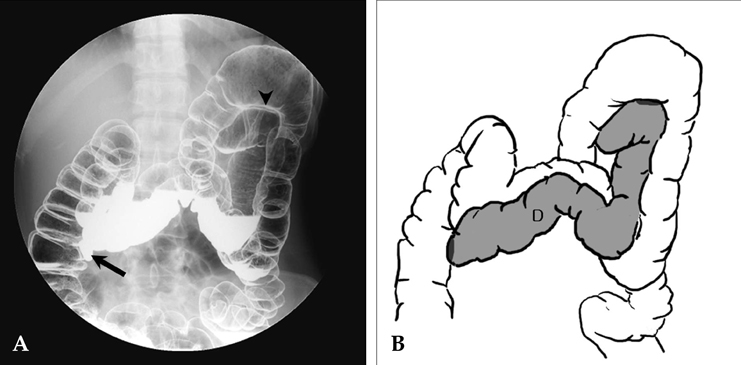Yonsei Med J.
2005 Feb;46(1):189-191. 10.3349/ymj.2005.46.1.189.
Asymptomatic Tubular Duplication of the Transverse Colon in an Adult
- Affiliations
-
- 1Department of Surgery, Yonsei University College of Medicine, Seoul, Korea. chcho@yumc.yonsei.ac.kr
- KMID: 2158135
- DOI: http://doi.org/10.3349/ymj.2005.46.1.189
Abstract
- Colonic duplication is a rare congenital anomaly of the alimentary tract. In most cases, symptomatic duplications of the colon are recognized and treated by childhood. It is uncommon for these lesions to be detected in the adulthood since they present with vague symptoms if at all. We experienced a case of asymptomatic tubular duplication of the transverse colon in a 40-year-old female. Barium enema revealed a tubular duplication of the transverse colon. The duplicated segment arose from the mid ascending colon and incorporated just proximal to the splenic flexure, running parallel to the transverse colon and communicating with it at both ends. Colonoscopy demonstrated a normal colonic mucosa in the duplicated segment. The diameter of its lumen gradually narrowed proximally and the colonoscope could not be passed through the proximal opening of the segment. The patient did not need any treatment. Duplications of the alimentary tract can be found at any age. The possibility of congenital lesions in the adult population should not be overlooked.
Keyword
MeSH Terms
Figure
Reference
-
1. Tamoney HJ Jr, Testa RE. Carcinoma arising in a duplicated colon. Case report. Cancer. 1967. 20:478–481.2. Stringer MD, Spitz L, Abel R, Kiely E, Drake DP, Agrawal M, et al. Management of alimentary tract duplication in children. Br J Surg. 1995. 82:74–78.3. Dutheil-Doco A, Ducou Le Pointe H, Larroquet M, Ben Lagha N, Montagne J. A case of perforated cystic duplication of the transverse colon. Pediatr Radiol. 1998. 28:20–22.4. Kang YW, Park WK, Lee JK, Kim YK. Duplication of the transverse colon: A case report. J Korean Soc Coloproctol. 2002. 18:59–63.5. Larizadeh R, Powell DE. Neoplastic change in a duplicated colon. Br J Surg. 1965. 52:666–668.6. Posthuma N, van Schaik C, Meuwissen SG, Cuesta MA. Tubular colonic duplication combined with unilateral renal hypoplasia. Am J Gastroenterol. 1991. 86:1833–1835.7. Hickey WF, Corson JM. Squamous cell carcinoma arising in a duplication of a colon: Case report and literature review of squamous cell carcinoma of the colon and of malignancy complicating colonic duplication. Cancer. 1981. 47:602–609.8. Bishop HC, Koop CE. Surgical management of duplications of the alimentary tract. Am J Surg. 1964. 107:434–442.9. Holcomb GW III, Gheissari A, O'Neill JA Jr, Shorter NA, Bishop HC. Surgical management of alimentary tract duplications. Ann Surg. 1989. 209:167–174.
- Full Text Links
- Actions
-
Cited
- CITED
-
- Close
- Share
- Similar articles
-
- Duplication of the Transverse Colon: A Case Report
- Complete tubular duplication of colon in an adult: a rare cause of colovaginal fistula
- A Case of Tubular Duplication of the Esophagus
- A Case of Tubular Esophageal Duplication
- Large tubular colonic duplication in an adult treated with a small midline incision



